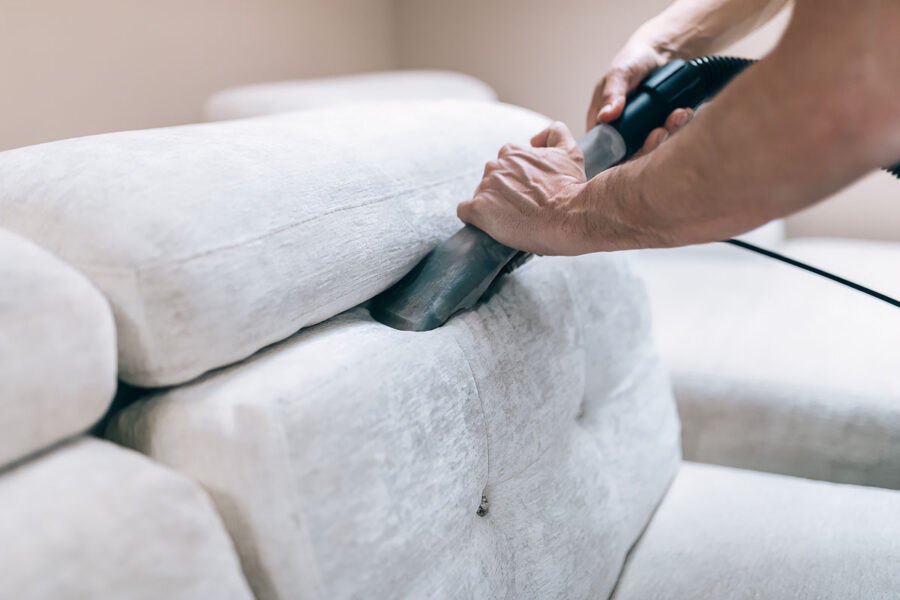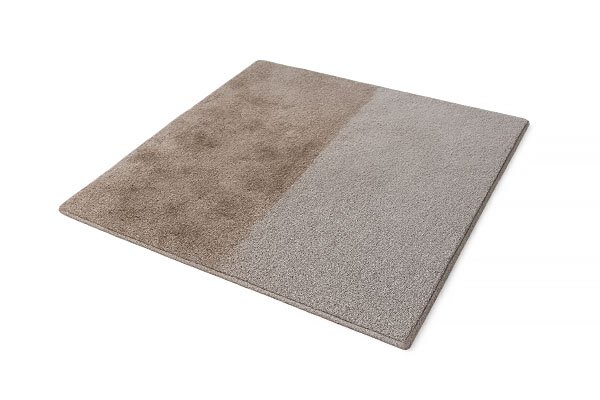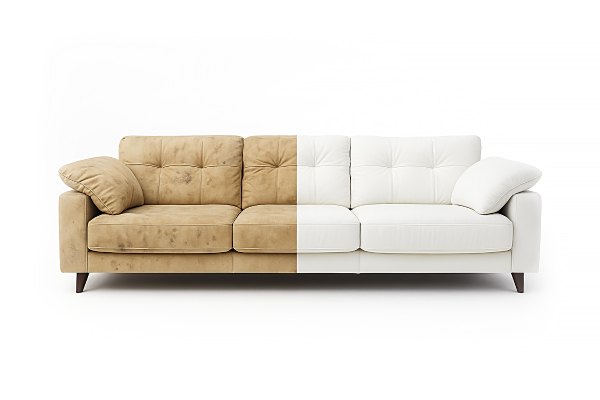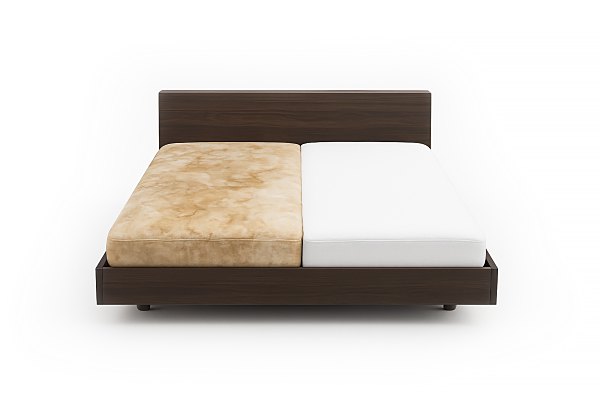Lounge upholstery cleaning often gets overlooked in regular home care. Most people clean floors and wipe surfaces but forget about their sofas and chairs. This neglect leads to dirt buildup, stains, and shortened furniture life. Clean upholstery matters for both health and home beauty. Dust mites, pet dander, and food crumbs hide in fabric fibers. These cause allergies and breathing problems. Dirty couches also look shabby and smell bad.
The right cleaning schedule depends on several factors. Homes with kids or pets need more frequent cleaning than adult-only households. High-traffic lounges need more care than rarely used formal sitting rooms. Fabric type also affects cleaning needs – delicate materials require special care while sturdy fabrics can handle stronger cleaning methods.
Most experts suggest professional upholstery cleaning every 6-12 months. This deep clean removes hidden dirt and refreshes fabric. Between these visits, regular vacuuming and spot cleaning help keep furniture looking good. Prompt attention to spills prevents permanent stains. Simple weekly care extends the time between deep cleans.
Climate matters too. In humid areas like coastal Australia, mold and mildew grow faster on fabrics. This means more frequent cleaning might be needed. Homes with air conditioning might need less frequent deep cleaning but still require regular maintenance.
The ultimate guide to keeping your lounge fresh year round
Fresh, clean upholstery creates a welcoming home environment. Regular care prevents dirt buildup and extends furniture life. A good cleaning routine includes daily, weekly, and seasonal tasks.
Daily quick care
Daily care takes just minutes but makes a big difference. Fluff cushions each morning to restore shape and prevent permanent creases. Brush off visible crumbs and pet hair before they settle into fibers. Wipe armrests and headrests with a dry microfiber cloth to remove oils from skin contact. These small habits prevent dirt from becoming embedded in fabric.
For homes with pets, keep a lint roller handy for quick fur removal. Place throws on favorite pet spots to catch hair and dander. Remove and wash these covers weekly for fresher furniture.
Weekly maintenance
Weekly care prevents dirt buildup and catches small problems before they grow. Vacuum upholstery using the appropriate attachment – usually a soft brush head. Pay special attention to seams, crevices, and under cushions where crumbs collect. Rotate removable cushions to ensure even wear on all sides.
Check for new stains or spots and treat them promptly. Most fresh stains come out with gentle blotting using appropriate cleaners. Test any cleaning product on a hidden area first to avoid damage.
Common Upholstery Cleaning Products:
- Mild dish soap solution (for water-safe fabrics)
- White vinegar solution (for odor removal)
- Baking soda (for deodorizing)
- Commercial upholstery cleaners (fabric-specific)
- Microfiber cloths (for gentle wiping)
Monthly tasks focus on deeper cleaning and preventive care. Deodorize fabric by sprinkling baking soda across surfaces, letting it sit for 15-30 minutes, then vacuuming thoroughly. This absorbs odors trapped in fibers.
Check furniture frames and supports for any issues. Loose legs or sagging springs need prompt attention to prevent further damage. Apply fabric protector to clean upholstery to resist future stains. These products create an invisible barrier against spills.
Seasonal refreshing
Each season brings different challenges for upholstery. Spring cleaning should focus on removing winter dust buildup and treating any water spots from rainy days. Summer care includes protection from sun fading by closing blinds during peak daylight. Fall maintenance prepares furniture for increased indoor time during cooler months. Winter care addresses holiday spills and extra wear from holiday gatherings.
Pro tip: Keep a cleaning calendar on your phone with reminders for daily, weekly, and seasonal tasks. This prevents forgetting important maintenance steps and spreads the work out into manageable chunks.
Signs your upholstery needs immediate cleaning attention
Sometimes furniture needs cleaning outside the regular schedule. Knowing these warning signs helps catch problems early.
Visible dirt and stains
The most obvious sign of dirty upholstery is visible soil. Dark patches on armrests show where hands rest regularly. Greasy spots on headrests indicate hair product buildup. Food and drink stains need prompt attention before they set permanently.
A simple test reveals hidden dirt. Rub a white cloth across fabric surfaces. If the cloth picks up color, the upholstery needs cleaning. Pay special attention to high-touch areas like armrests and headrests.
Stains that change color or spread indicate deeper problems. Coffee stains that turn brown at the edges show the liquid has penetrated deep into padding. Red wine stains that look purple suggest mold growth beneath the surface.
Unpleasant odors
Bad smells signal bacteria growth in upholstery. Musty odors indicate mold or mildew, especially in humid climates. Sour smells often come from food spills that weren’t fully cleaned. Pet odors linger in fabric long after accidents.
These smells worsen over time as bacteria multiply. Air fresheners only mask the problem temporarily. True odor removal requires deep cleaning to eliminate the source.
Some odors pose health risks. Mold spores cause breathing problems and allergic reactions. Bacterial growth from food spills can spread illness. Pet urine contains ammonia that irritates eyes and lungs.
Health symptoms
Dirty upholstery affects health in surprising ways. Frequent sneezing when sitting on the couch suggests dust mite buildup. Itchy skin after contact with fabric points to allergen accumulation. Worsening asthma symptoms indoors often link to dirty soft furnishings.
Common Allergens in Upholstery:
- Dust mites and their waste
- Pet dander and fur
- Pollen tracked in from outdoors
- Mold spores
- Food particles
Children show these symptoms more obviously than adults. Their developing immune systems react strongly to allergens. If kids sneeze or cough more when playing on certain furniture, those pieces need cleaning.
Fabric deterioration
Dirty fabric breaks down faster than clean material. Stiff, rough texture replaces once-soft upholstery. Faded colors appear where dirt particles scratch fiber surfaces. Weak spots develop where dirt cuts into threads.
Check seams for dirt buildup and weakening threads. Test fabric strength by gently pressing a fingernail against it. Clean fabric springs back while dirty, deteriorating material stays compressed.
Pro tip: Take dated photos of furniture every few months to track gradual changes in appearance. Side-by-side comparisons reveal dirt buildup and fabric deterioration that happens too slowly to notice day by day.
Professional furniture upholstery cleaning services in Sydney provided by SevenClean
Professional cleaning extends furniture life and restores beauty. SevenClean offers top-quality upholstery services across Sydney.
About SevenClean
SevenClean stands out among Sydney cleaning companies. This local business specializes in fabric care and restoration. Their trained technicians understand different materials and cleaning methods.
The company uses eco-friendly cleaning products safe for families and pets. These solutions clean effectively without harsh chemicals that damage fabric or harm health. Their equipment extracts dirt from deep within furniture padding, not just surface cleaning.
SevenClean offers flexible scheduling including weekend and evening appointments. This convenience helps busy households maintain clean furniture without disrupting work schedules. Emergency cleaning services handle unexpected spills and stains promptly.
SevenClean services
Comprehensive cleaning services
SevenClean provides complete home cleaning solutions beyond just upholstery care. Their service range covers all soft furnishings and floor coverings.
The furniture upholstery cleaning service addresses sofas, chairs, ottomans, and dining chairs. Technicians pre-test fabrics to determine safe cleaning methods. They use hot water extraction for deep cleaning and faster drying. Spot treatment targets stubborn stains before general cleaning begins. The process removes allergens, dust mites, and odors from deep within padding.
Mattress cleaning improves sleep quality by removing allergens and dust mites. The process includes vacuuming, spot treatment, sanitizing, and deodorizing. This service helps people with allergies and asthma breathe easier during sleep. Regular mattress cleaning extends mattress life and maintains comfort.
Carpet and rug cleaning restores floor coverings to like-new condition. The company handles all carpet types including wool, synthetic, and delicate oriental rugs. Their process removes deep dirt that regular vacuuming misses. Stain protection treatment helps carpets stay cleaner between professional visits.
SevenClean Service Benefits:
- Trained technicians with material knowledge
- Eco-friendly cleaning solutions
- Modern equipment for deep cleaning
- Stain protection treatments
- Same-day service for emergencies
- Satisfaction guarantee
Pro tip: Book combined services like upholstery and carpet cleaning together for package discounts. This approach ensures all soft furnishings get cleaned to the same standard at the same time.
Seasonal cleaning schedule for different fabric types.
Different fabrics need specific care approaches. A seasonal schedule keeps all furniture types in top condition.
Cotton and linen care
These natural fibers show dirt easily but clean well with proper methods. Spring cleaning should include thorough vacuuming and spot treatment of winter stains. Summer maintenance focuses on sun protection as these fibers fade easily. Fall preparation includes applying fabric protector before the busy holiday season. Winter care addresses food and drink spills promptly during gathering seasons.
Cotton and linen absorb moisture readily. In humid summer months, check for mildew growth regularly. Use fans to speed drying after cleaning these materials. Avoid harsh chemical cleaners that break down natural fibers.
These fabrics wrinkle easily. Smooth cushions after cleaning to prevent permanent creases. Steam works well for removing wrinkles without chemicals. Professional cleaning twice yearly keeps these materials fresh and strong.
Leather and vinyl maintenance
These smooth surfaces need different care than fabric upholstery. Spring cleaning includes conditioning leather after winter heating dries it out. Summer care focuses on preventing sun damage through window treatments. Fall preparation means deep conditioning before heating season begins. Winter maintenance includes prompt wiping of salt and water marks from boots and coats.
Leather Care Calendar:
- Spring: Deep clean and condition after winter dryness
- Summer: Protect from direct sunlight and air conditioning
- Fall: Apply leather protector before heating season
- Winter: Wipe salt and water marks promptly
Leather needs regular conditioning to prevent cracking. Apply quality leather conditioner quarterly to maintain suppleness. Clean spills immediately with appropriate leather cleaners. Never use household cleaners on leather as they cause damage.
Vinyl requires gentle cleaning to prevent surface scratches. Use soft cloths and cleaners made specifically for vinyl. Check seams regularly for dirt buildup that can cause splitting. Professional cleaning once yearly removes body oils that home cleaning misses.
Synthetic fabric treatment
Polyester, nylon, and microfiber have different care needs than natural materials. Spring refreshing includes static reduction treatments after dry winter months. Summer maintenance focuses on removing sunscreen and body oil buildup. Fall preparation includes thorough cleaning before increased indoor use. Winter care addresses holiday stains promptly.
Synthetic fabrics attract dust through static electricity. Use anti-static sprays to reduce this problem. Vacuum frequently with brush attachments that won’t snag fibers. Blot spills immediately as some synthetics repel water initially but absorb it over time.
Microfiber requires special attention. Clean with alcohol-based products rather than water to prevent water stains. Use soft brushes to restore nap after cleaning. Professional cleaning annually removes oils that home methods miss.
Pro tip: Create a fabric care reference card for each furniture piece. Note the material type, recommended cleaning products, and professional cleaning schedule. Keep these cards in a home maintenance binder for quick reference when spills happen.
Extend your lounge life with proper maintenance routines
Good maintenance doubles or triples furniture lifespan. Regular care prevents permanent damage and keeps furniture looking new.
Daily protection habits
Small daily habits prevent big problems later. Use coasters under drinks to prevent water rings and spills. Place washable throws over high-use areas to catch daily dirt. Remove shoes before lounging to prevent transferring outdoor grime to upholstery. Keep snacks on trays rather than eating directly over furniture.
Train pets to stay off furniture or provide their own beds nearby. If pets do use furniture, keep blankets on their favorite spots. Wash these pet covers weekly to control odors and dander.
Position furniture away from direct sunlight to prevent fading. Use window treatments during peak sun hours. Keep furniture at least 30cm from heating vents to prevent fabric drying and potential fire hazards.
Weekly cleaning routine
Regular light cleaning prevents dirt buildup. Vacuum upholstery weekly using appropriate attachments. Remove cushions to clean underneath and in crevices. Brush fabrics with a soft upholstery brush to lift embedded dirt.
Spot clean new stains immediately with appropriate cleaners. Blot rather than rub to prevent spreading the stain. Test cleaning products on hidden areas first to avoid damage.
Rotate cushions weekly to ensure even wear. This prevents one area from becoming compressed or faded. Fluff pillows to maintain their shape and support.
Professional maintenance schedule
Expert care complements home maintenance. Schedule professional cleaning every 6-12 months depending on usage. Homes with children, pets, or smokers need more frequent professional cleaning.
Professional Maintenance Timeline:
- Every 6 months: High-traffic furniture in family homes
- Every 9 months: Moderate-use furniture in homes with pets
- Every 12 months: Light-use furniture in adult-only homes
- Every 3-4 months: Homes with allergy sufferers
Choose cleaning companies with experience in your specific upholstery type. Ask about their cleaning methods and make sure they suit your furniture materials. Request fabric protection treatment after cleaning to resist future stains.
Keep records of professional cleanings including dates and services performed. This documentation helps track furniture condition over time and may be needed for warranty claims.
Pro tip: Take before and after photos when furniture gets professionally cleaned. These visual records help track gradual changes in appearance and show when it’s time for the next cleaning.
Professional vs DIY cleaning methods for Australian homes
Both professional and DIY approaches have their place in upholstery care. Understanding the strengths of each helps make smart cleaning choices.
When to DIY clean
Some situations suit home cleaning methods perfectly. Fresh spills need immediate attention before they set. Blot liquids with clean white cloths to absorb as much as possible. Apply appropriate cleaners based on fabric type and stain source.
Regular maintenance cleaning works well as DIY. Vacuum weekly with upholstery attachments. Spot clean small marks before they become permanent. Apply fabric fresheners to control minor odors between deep cleanings.
Budget constraints sometimes make DIY necessary. Rental steam cleaners offer deeper cleaning than vacuuming alone. Follow machine instructions carefully to avoid overwetting furniture. Allow extra drying time in humid Australian conditions.
When to call professionals
Some situations demand professional expertise. Set-in stains that resist home treatment need professional attention. Old stains often require specialized solutions and equipment. Professionals identify the stain type and use appropriate treatments.
Valuable or antique furniture deserves expert care. Professional cleaners understand delicate fabrics and construction methods. They choose gentle but effective cleaning approaches for precious pieces.
Health concerns indicate professional cleaning needs. Persistent allergies or asthma symptoms suggest allergens in upholstery. Professional cleaning removes these triggers more effectively than home methods. Mold or mildew problems require professional sanitizing treatments.
Cost comparison
Price differences between DIY and professional methods vary widely. Home cleaning supplies cost $20-50 for basic spot cleaners and fabric fresheners. Rental steam cleaners run $40-60 per day plus solution costs. These methods save money for routine maintenance.
Professional cleaning costs $100-300 for a standard three-seat sofa. Larger sectionals or specialty fabrics cost more. This investment brings deeper cleaning and expert stain removal. Many companies offer package discounts when cleaning multiple furniture pieces.
Value Considerations:
- Time saved through professional service
- Equipment quality difference
- Cleaning solution effectiveness
- Risk of damage from improper DIY methods
- Warranty requirements for professional cleaning
Pro tip: Combine approaches for best results. Handle routine maintenance and fresh spills yourself. Schedule professional cleaning yearly for deep soil removal and fabric restoration. This balanced approach maximizes furniture life while controlling costs.
Conclusion
Proper upholstery cleaning maintains both furniture beauty and family health. The right cleaning schedule depends on household composition, fabric type, and usage patterns. Most homes benefit from professional cleaning every 6-12 months, with more frequent service for busy households with children and pets.
Between professional visits, regular maintenance prevents dirt buildup. Weekly vacuuming removes surface dust before it embeds in fibers. Prompt attention to spills prevents permanent staining. Fabric protectors applied after cleaning help resist future soiling.
Different fabrics need specific care approaches. Natural fibers like cotton and linen require gentle cleaning methods. Leather needs regular conditioning to prevent drying and cracking. Synthetic materials often resist staining but trap odors that need special treatment.
Professional services like those offered by SevenClean provide deep cleaning beyond what home methods achieve. Their trained technicians understand different materials and choose appropriate cleaning methods. Professional equipment extracts dirt from deep within padding, not just surface cleaning.
The investment in regular upholstery care pays off through extended furniture life and healthier home environments. Clean upholstery looks better, smells fresher, and contains fewer allergens than neglected furniture. This maintenance preserves both the financial investment in quality furniture and the comfort of home living spaces.





